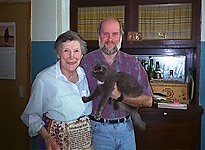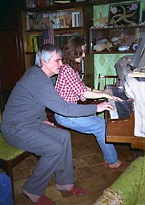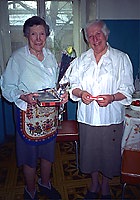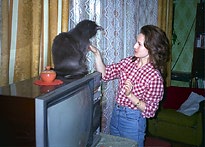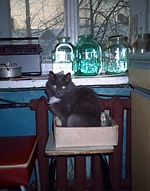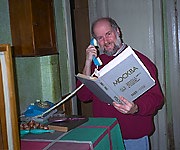At nine feet high and three inches thick, the large double doors that connect my room to the dining room are a reminder that I'm staying in what was once part of an elite apartment building of the Russian bourgeois in pre-revolutionary times. Twelve foot ceilings, an oriental rug over a well-worn wooden floor and two enormous windows complete the room. The windows are the most interesting for they show that the walls are over two feet thick. The outer windows consist of 6 large panels each in heavy wooden casements that can be opened by turning a large metal lever. Snow is piled high on the window ledges. The inner windows are set in the middle of the wall creating a 1-foot dead air space to the outer windows. The glass panes were rolled, not floated on molten tin like modern windows. Thus, the view outside is slightly distorted as if it were raining. The apartment building is located on Koliconica Street, just two subway stops from Moscow's Red Square district. House plants in red clay garden pots set on the 1-foot window sills. In one of the southern windows, a lemon tree grows and occasionally flowers and bears lemons. My room is also furnished with wooden stackable bookcases with glass doors, a bed, a dresser and a desk. A wind-up clock loudly ticks away the seconds and reminds me of sleeping at my grandparents' as a child.

The only modern thing in this room is the Mtec computer with which I am composing and e-Mailing these messages. The computer is a Russian 486 PC equipped with Windows95. The rest of the apartment consists of three other sleeping rooms, a dining room with a grand piano, a spacious kitchen and an office.
The apartment is occupied by several people including Mikhail Goldfeld, my friend who helped organize the trip and his 84-year old mother, Leah Gurvich. Mikhail is currently a professor at Ball State University in Indiana but maintains this Moscow apartment and makes frequent trips back and forth. Another family, consisting of Timus and Roza and their daughter, Inna, also lives here. Timus and Roza grew up in Tartarya, a thousand miles south and east of Moscow.

Leah, Roza, Inna and Leah's cousin Dora prepared a wonderful meal to welcome us to Russia. Upon our arrival at 2 PM we were shown to our rooms after trading our shoes for house slippers. The dining room table was set with plates of three meats (turkey, sausage and salted fish similar to salmon), three salads (a beet salad and another contained peas, cabbage, green onions, carrots, and tuna -- very tasty) and champagne. I overate not realizing that this was just the first course! Next came large bowls of carrot and cabbage soup served with a dollop of sour cream and sliced green onions. Again delicious. The third course consisted of baked chicken and beef with potatoes. Then we rested and talked. Ed and I learned how to send e-Mail and we started planning for our first program on Monday. At 8 PM we had the final course: apple pie, tea, chocolates (domestic and Hershey's) and Georgian wine.
Sunday morning Ed and I organized our first demonstration program. All of the demonstrations made it to Moscow without breaking, a remarkable feat considering that I normally have a hard time carrying these same things to class without breaking something! In the afternoon we went to the apartment of Elena Rotina, director of the Association for the Advancement of Chemical Education of the Russian Chemical Society named for D. I. Mendeleev. Elena, along with Mikhail organized the trip itinerary. We had another elaborate meal that lasted several hours. Before the dessert courses, (there were two desserts -- ice cream covered with wine and strawberries and later a 10-layer chocolate cake with tea) we danced in the apartment. I'm afraid I may have disgraced the USA with my stiff style.

One final note about Leah's apartment. Anyone that travels much realizes that the whole world doesn't all use the American toilet design. Next to this rather unusual Russian toilet is a curious blue plastic tray within a tray. The inside tray has numerous holes that drain to the lower tray. The device belongs to Hustis (pronounced hyou-stis), the family cat. I wonder if Hustis would have as much trouble figuring out the use of an American cat's litter box as I had figuring out how to operate the Russian toilet for people?
Go to Chapter 2
Back to the Table of Contents
